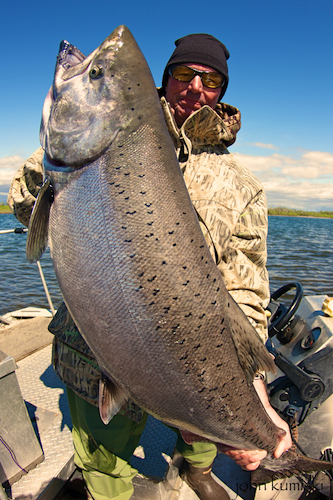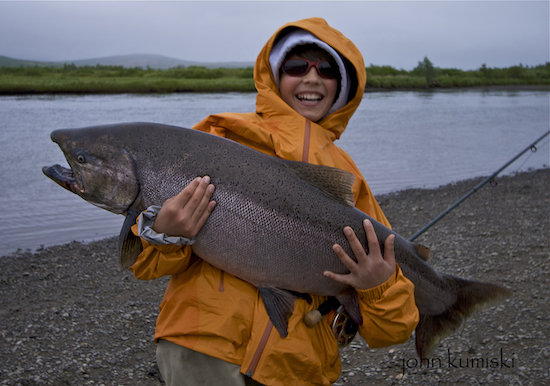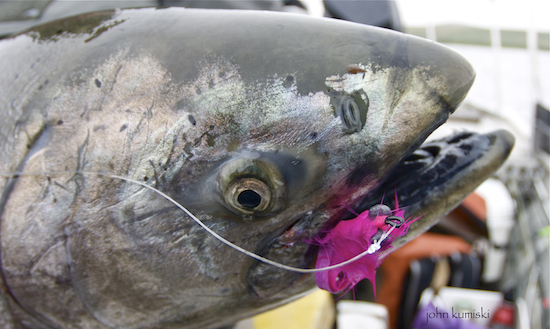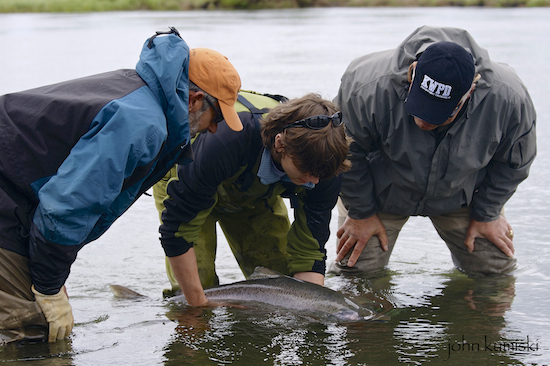King Salmon On Fly
Fresh-from-the-sea king salmon provide the biggest thrills in salmon fishing. You can multiply those thrills 10-fold by fishing king salmon on fly.
You’ll need some serious tackle for these chrome kings. While under exceptional circumstances you’ll be able to sight fish them with a floating line, ordinarily the fish lie in the deeper, faster places in the river.
Most of the time to get the fly down to them, you’ll need a fast-sinking, 500-grain line that you’ll be tossing with a 9-foot, 10-weight rod. Spey (oversized) tackle is gaining popularity, and allows die-hard waders a better chance at distant fish. You’ll need a minimum of 100 yards of 30-pound Dacron backing on your reel, and more is better. A big king in a heavy current will take some line.
Depending on conditions, leaders will range from 6- to 12 feet long. The clearer the water, the longer the leader needs to be. A 12- or 15-pound tippet proves adequate, and again, clearer water demands the finer tippet.
Cerise Bunny Leech Works
If you find a website of Alaskan flies you will see that many different fly patterns are used for king salmon on fly. Day-in and day-out on southwest Alaska’s Goodnews River we use a heavily-weighted cerise (a purplish-red color) bunny leech, size 2, for these fish. If they are being finicky, we switch to an articulated, heavily-weighted, cerise bunny leech. And while it’s never a bad idea to have some variety in your fly box for those days when the tried-and-true isn’t working, that cerise leech will cover 90-plus percent of your fly needs. Black, purple, orange, and chartreuse are other colors to consider carrying.
The holes the fish use for lies change little from year to year. Generally, the local anglers will know all of them. Also, again generally, you need a boat to fish for kings unless the river is quite small. Since kings prefer the deeper, faster water, they are not usually wader friendly.
You’ll enjoy the best success by hiring a good guide. If you want to do it yourself, drift down the river and look for fish rolling at the surface. Or idle up the river and look for fish rolling. Either way, the key to finding them is moving slowly and being observant. If you get good light (in my experience a rare occurrence during the king run), you can see them down near the bottom if the hole is shallow enough. But you’ll need to put your time in and use your observation skills, including watching other anglers.
Once you find them, you still need to get a bite or two. As a rule, you’ll cast quartering down stream. Once the line hits the water you mend two or three times while simultaneously feeding line out. Give the line and fly a chance to sink.
Make Sure Fly Is Down
Once you think the fly is down, hold the line and the current will swing the fly. If the fish sees the fly at this point they will often follow it. Once you get his attention you need to sell him. You do this with the false strip.
Grab the line near the stripping guide. Strip it back to the reel. Then let it go. The current will pull the line back out of the guides, and the fly will fall back with the current. When the line comes tight the fly will start to lift. This is usually when the bite happens.
You can false strip over and over, pointing the rod to the right, then to the left, working a wide swatch of water and hardly casting at all. If you can bump the boat downstream while at anchor, you can make just one or two casts and work most of a pool. It’s almost like back-trolling a plug and is very effective.
Once a big king feels the steel, he’ll usually tear off downstream. On the Goodnews, we pull the anchor and float after them, rowing the boat towards the nearest gravel bar. Doing this allows the angler to fight the fish on foot, and it gets the fish out of the fastest current.
Release The Big Ones
It’s hard to move even a dead tired fish in a heavy current, especially if it has to be pulled upstream. Since kings often top 50 pounds, this is a very real consideration. It’s easier on both fish and fisherman to move the battle to calmer water.
On the Goodnews, we generally release any fish over 12 pounds or so, allowing them to continue upriver to spawn. Let them pass on those big fish genes! We keep the runts to eat, removing them from the gene pool. It makes a lot of sense.
Try king salmon on fly. You’ll discover how challenging and how rewarding salmon fishing can be.
John Kumiski
http://www.spottedtail.com
Copyright © John A. Kumiski 2022. It is illegal to reproduce or distribute this work in any manner or medium without written permission from the author, John A. Kumiski, 284 Clearview Road, Chuluota, FL 32766 (407) 977-5207.
If you found this article useful and would like to donate to Spotted Tail, please click here…
![]()




